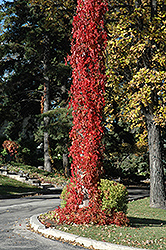Virginia Creeper
Parthenocissus quinquefolia
Height: 40 feet
Spread: 24 inches
Sunlight:
![]()
![]()
![]()
Hardiness Zone: 2
Other Names: Woodbine
Description:
A popular, tough and hardy vine for screening, excellent along fences and arbors, up the sides of houses or climbing trees; features interesting five-lobed leaves that turn red and purple in fall, small black berries; self-clinging, extremely adaptable
Ornamental Features
Virginia Creeper has dark green deciduous foliage which emerges brick red in spring on a plant with a spreading habit of growth. The serrated palmate leaves turn an outstanding red in the fall.
Landscape Attributes
Virginia Creeper is a dense multi-stemmed deciduous woody vine with a twining and trailing habit of growth. Its average texture blends into the landscape, but can be balanced by one or two finer or coarser trees or shrubs for an effective composition.
This woody vine will require occasional maintenance and upkeep, and can be pruned at anytime. It is a good choice for attracting birds to your yard, but is not particularly attractive to deer who tend to leave it alone in favor of tastier treats. It has no significant negative characteristics.
Virginia Creeper is recommended for the following landscape applications;
- Hedges/Screening
- General Garden Use
Planting & Growing
Virginia Creeper will grow to be about 40 feet tall at maturity, with a spread of 24 inches. As a climbing vine, it tends to be leggy near the base and should be underplanted with low-growing facer plants. It should be planted near a fence, trellis or other landscape structure where it can be trained to grow upwards on it, or allowed to trail off a retaining wall or slope. It grows at a fast rate, and under ideal conditions can be expected to live for approximately 20 years.
This woody vine performs well in both full sun and full shade. It is very adaptable to both dry and moist locations, and should do just fine under average home landscape conditions. It is considered to be drought-tolerant, and thus makes an ideal choice for xeriscaping or the moisture-conserving landscape. It is not particular as to soil type or pH, and is able to handle environmental salt. It is highly tolerant of urban pollution and will even thrive in inner city environments. This species is native to parts of North America.

